Boy howdy, peanut-brittle and sausages, do some of these posts take way more time than they really should! But I’ll go into that later. Right now, we have a simple (!) follow-up on the anole front.
After finding the adult Carolina anole (Anolis carolinensis) snoozing in the oak-leaf hydrangea in the previous post, I’ve been keeping an eye on that particular lizard, because it’s been making it easy – it returns to the same spot every night, and can on occasion be found foraging on the bush during the day.

While I have yet to witness this in action, I’ve found that the anole takes its perch near sundown, while there is still plenty of light in the sky, but at that point is deep brown, blending in with the dried flowers remarkably well – it is only after night falls that they turn quite pale. I’m only guessing, but I suspect this is because, after the birds bed down themselves, there’s no reason to be camouflaged and they can adapt a color that optimizes their temperature for the night, and/or collects dew faster. But as I’ve said before, lizardology ain’t my degree, I just takes da piccies…
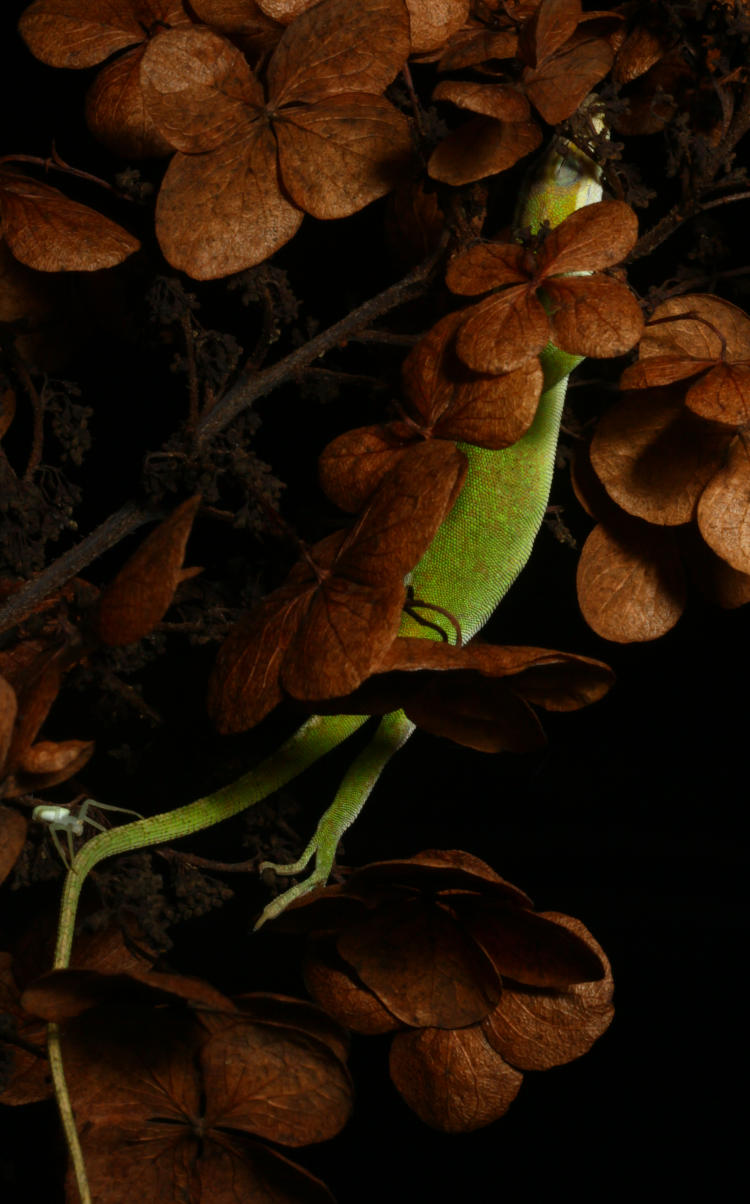
We needed another angle on that same one, showing the one foot just splayed against the dried flowers; the anole appears to be supported solely by its two left feet hooked onto the branches. But what’s that down there?
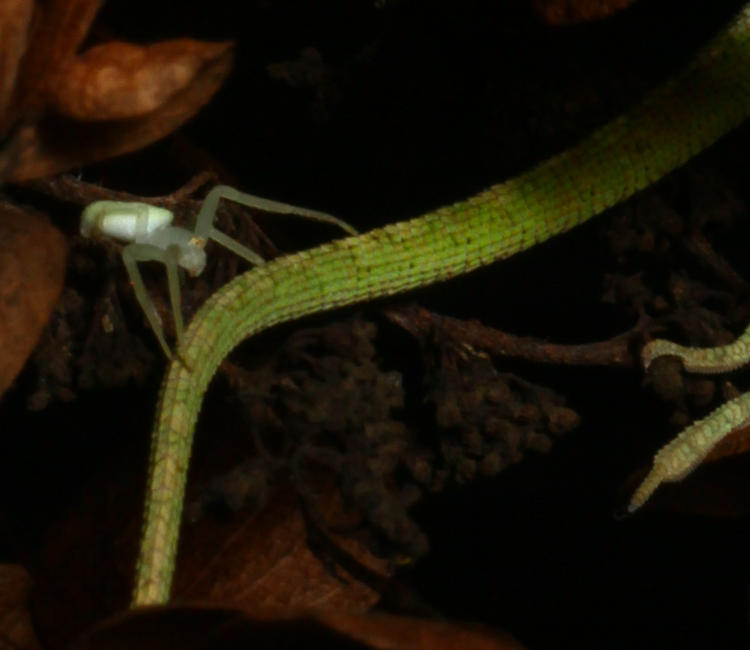
We have what appears to be an opportunistic white-banded crab spider (Misumenoides formosipes) literally sizing up the anole, or perhaps just posing for a novelty photo like the typical idiots with wildlife in national parks; there’s no doubt that the anole would scarf the spider up immediately if it were awake. Have your fun, little spider, your days are numbered.
More interesting, however, was Saturday’s find on the butterfly bush (Buddleia davidii.) It was basking on a leaf when I spotted it with my hands full, and when I returned with the camera it was spooking into the Japanese maple.

That’s pretty much a newborn anole, the first appearance of any this year, and this is perhaps the best sense of scale that I obtained (so far, anyway) – the pale curve in the background is a standard-sized planter, maybe 30cm across, but a video clip from last year shows a better comparison. I have no idea how long after birth they might remain deep in concealment before venturing out like this, but I’ve been keeping my eyes open for just such appearances so this is certainly among the first few days of being in public, as it were. Given this one disappearing into the maple, I figured I’d lost my chance for a decent shot for a while, and I wandered off seeking other photo opportunities. Yet just a few minutes later, as I came back around the butterfly bush, it was basking in almost the exact same location that I’d first spotted it.

If you know butterfly bushes, you know that leaf is perhaps 100mm in length and no more than 20 wide; this spud is tiny. But unlike its discretion only a few minutes previously (which might have been provoked by carpenter bees visiting the flower clusters,) this time it largely stayed put, and I could get a variety of angles as long as I moved cautiously.
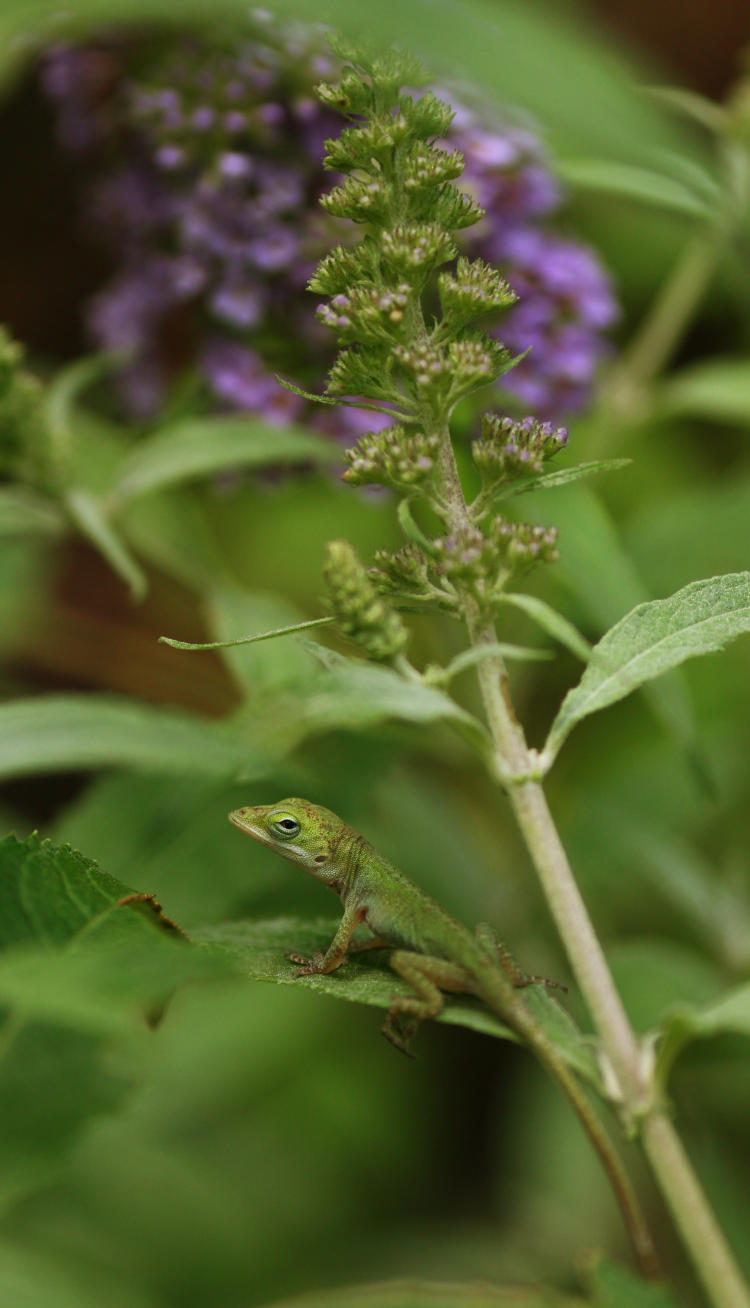
I would have liked it to have taken up a perch on the flower clusters themselves, but the anole probably knew instinctively that this wasn’t good camouflage or shelter, so for now we just have this pose near a smaller budding cluster. But we need to see the detail from this frame, at full resolution:

The length of this head is roughly the width of a standard pencil, and yet, seen this close, there’s virtually nothing that distinguishes it from an adult many times its size, except maybe the spindly legs; it still possesses the mosaic scale detail and even the proportions of the adult, and the mottling makes it seem way older than a few days or so. A typical housefly would be a hell of a mouthful for this fella – maybe someday I’ll get some pics along those lines. I tried, even with video:
It’s funny: I recognize the issues with doing handheld macro video, but I have yet to find decent ways to surmount them. No, there are no stabilizing rigs that can handle a heavy DSLR and still allow things like tilting forward on demand. I would say I’d design one and market it to other macro videographers, but that’s not a lucrative market – few of them have any more money than I do.
But I know you’re skeptical over the behavior that I mentioned and illustrated in that video, not exactly sure that I’d actually seen what I claimed, so I present another example, an animated gif (pronounced, “grrrr-ATE”) of four frames from just a bit earlier.
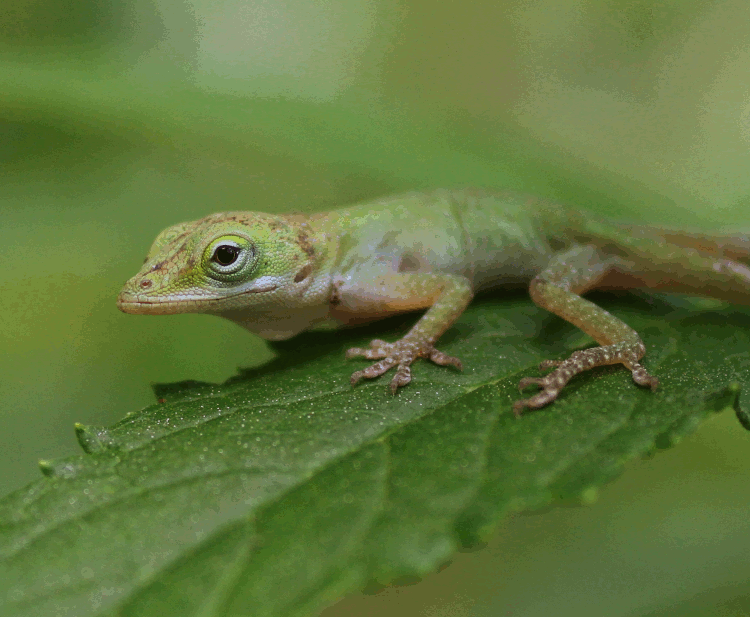
I realized what I was seeing just as I was snapping the first frame and so kept going, unable to switch to video fast enough, but this is adequate. That dewlap, while not exactly displaying like an adult, is undoubtedly extending a little. And no, this is not a ‘swallow’ or anything, because I saw it more than once – in fact, I’d first seen it, almost disbelievingly, last year and vowed to capture video of it but never got another opportunity. It’s so cute when they act tough.
I had brought The Girlfriend out to see my subject here, and she suddenly told me to turn around and check the center stem of the hosta plants about a meter away. She’s getting to be pretty good at this herself.
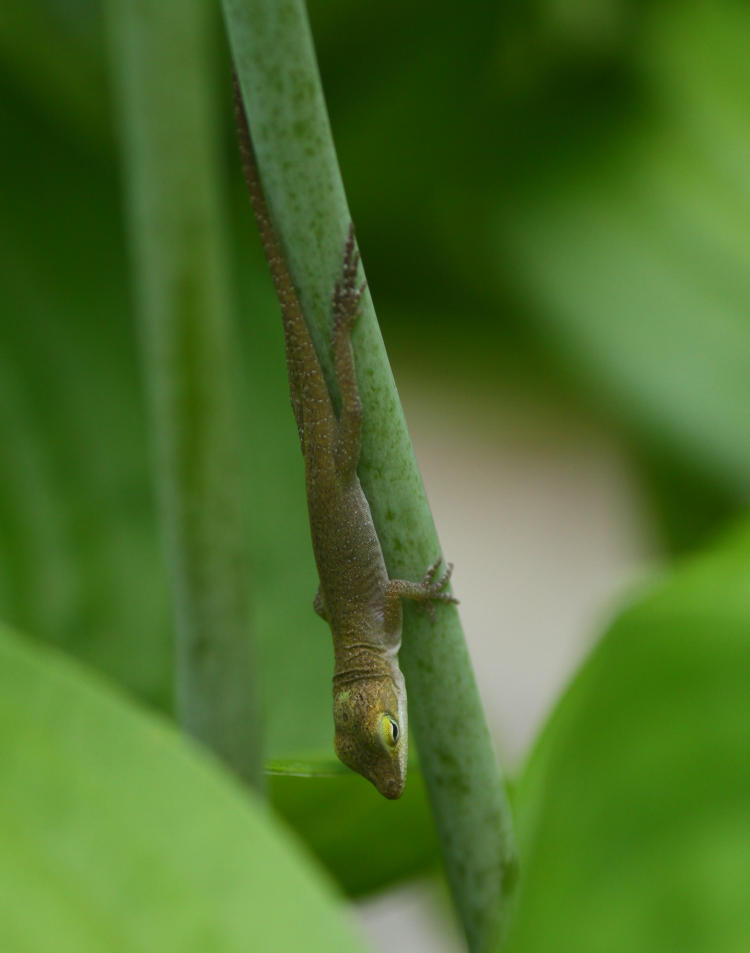
Yep, another newborn, and perhaps slightly bigger in size than the first, but not by more than 10%, and I would have to see them side-by-side to confirm it anyway. You know I’m pleased; I love the idea that Walkabout Estates is home to a colony of this species. Now if I can just get some meerkats established…
Even while it knew I was right there, this one scampered up in plain sight atop one of the big hosta leaves and posed, and I went a bit wider for a slightly more scenic shot:

Will I be able to tell these two apart in any way? Not likely, though I perceived this one to be a little more active than the other, and will endeavor to observe them closely enough that I can distinguish them by behavior – not holding my breath, but it’s not out of the realm of possibility.
We’ll close with one last shot of the second one, deciding for whatever reason to scamper up the flower stems again and shelter in among the seeds, though whether this was due to my presence or not I can’t say; it certainly danced around quite a bit before it chose to climb up there.

Even if you have no idea what the seeds are, they seem to communicate their size better and give more of a sense of scale, but maybe it’s just me. I missed my video opportunity here, though I hadn’t known it was going to happen, since as the anole gained the seeds its coloration deepened into brown; I do have a goal of illustrating how quickly they can change color, but it often takes some provocation that I’m not likely to induce myself. Many years ago in Florida I witnessed a territorial dispute between a Carolina and Cuban anole, and the Carolina changed into deep brown within about two seconds, which immediately caused the Cuban to rush it. Still not sure what this said, but I definitely vowed to capture something similar one day. Maybe this’ll be the year.




















































